Enhancement of Medium-Carbon Steel Corrosion and Wear Resistance by Plasma Electrolytic Nitriding and Polishing
Abstract
:1. Introduction
2. Materials and Methods
3. Results
3.1. X-ray Diffraction Analysis and Cross-Section Microstructure
- − Oxide layer that contained FeO and Fe3O4;
- − Nitride-martensite layer that contained Fe4N, martensite and retained austenite;
- − Martensite layer that contained martensite, retained austenite and solid solution of nitrogen);
- − Initial pearlite-ferrite structure.
3.2. Surface Morphology
3.3. Material Removal and Surface Roughness
3.4. Microhardness
3.5. Corrosion Resistance
3.6. Wear Resistance
4. Discussion
5. Conclusions
Author Contributions
Funding
Institutional Review Board Statement
Informed Consent Statement
Data Availability Statement
Conflicts of Interest
References
- Gallo, S.C.; Dong, H. On the fundamental mechanisms of active screen plasma nitriding. Vacuum 2010, 84, 321–325. [Google Scholar] [CrossRef]
- Nishimoto, A.; Nagatsuka, K.; Narita, R.; Nii, H.; Akamatsu, K. Effect of the distance between screen and sample on active screen plasma nitriding properties. Surf. Coat. Technol. 2010, 205, S365–S368. [Google Scholar] [CrossRef]
- Kurelo, B.C.E.S.; de Souza, G.B.; da Silva, R.S.L.; de Daudt, N.F.; Alves, C., Jr.; Torres, R.D.; Serbena, F.C. Tribo-mechanical features of nitride coatings and diffusion layers produced by cathodic cage technique on martensitic and supermartensitic stainless steels. Surf. Coat. Technol. 2015, 275, 41–50. [Google Scholar] [CrossRef]
- Grigoriev, S.; Metel, A. Plasma- and beam- assisted deposition methods. NATO Sci. Ser. II Math. Phys. Chem. 2004, 155, 147–154. [Google Scholar] [CrossRef]
- Metel, A.S.; Grigoriev, S.N.; Melnik, Y.A.; Prudnikov, V.V. Glow discharge with electrostatic confinement of electrons in a chamber bombarded by fast electrons. Plasma Phys. Rep. 2011, 37, 628–637. [Google Scholar] [CrossRef]
- Grigoriev, S.N.; Metel, A.S.; Fedorov, S.V. Modification of the structure and properties of high-speed steel by combined vacuum-plasma treatment. Met. Sci. Heat Treat. 2012, 54, 8–12. [Google Scholar] [CrossRef]
- Vereschaka, A.A.; Volosova, M.A.; Grigoriev, S.N.; Vereschaka, A.S. Development of wear-resistant complex for high-speed steel tool when using process of combined cathodic vacuum arc deposition. Procedia CIRP 2013, 9, 8–12. [Google Scholar] [CrossRef] [Green Version]
- Grigoriev, S.N.; Melnik, Y.A.; Metel, A.S.; Panin, V.V.; Prudnikov, V.V. Broad beam source of fast atoms produced as a result of charge exchange collisions of ions accelerated between two plasmas. Instrum. Exp. Tech. 2009, 52, 602–608. [Google Scholar] [CrossRef]
- Metel, A.S.; Grigoriev, S.N.; Melnik, Y.A.; Bolbukov, V.P. Characteristics of a fast neutral atom source with electrons injected into the source through its emissive grid from the vacuum chamber. Instrum. Exp. Tech. 2012, 55, 288–293. [Google Scholar] [CrossRef]
- Sobol’, O.V.; Andreev, A.A.; Grigoriev, S.N.; Gorban’, V.F.; Volosova, M.A.; Aleshin, S.V.; Stolbovoi, V.A. Effect of high-voltage pulses on the structure and properties of titanium nitride vacuum-arc coatings. Met. Sci. Heat Treat. 2012, 54, 195–203. [Google Scholar] [CrossRef]
- Parfenov, E.V.; Yerokhin, A.; Nevyantseva, R.R.; Gorbatkov, M.V.; Liang, C.-J.; Matthews, A. Towards smart electrolytic plasma technologies: An overview of methodological approaches to process modelling. Surf. Coat. Technol. 2015, 269, 2–22. [Google Scholar] [CrossRef] [Green Version]
- Sen Gupta, S.K. Contact glow discharge electrolysis: A novel tool for manifold applications. Plasma Chem. Plasma Process. 2017, 37, 897–945. [Google Scholar] [CrossRef]
- Krivenko, A.G.; Manzhos, R.A.; Kotkin, A.S. Plasma-assisted electrochemical exfoliation of graphite in the pulsed mode. High Energy Chem. 2018, 52, 272–273. [Google Scholar] [CrossRef]
- Krivenko, A.G.; Manzhos, R.A.; Kochergin, V.K.; Malkov, G.V.; Tarasov, A.E.; Piven, N.P. Plasma electrochemical synthesis of few-layer graphene structures for modification of epoxy binder. High Energy Chem. 2019, 53, 254–260. [Google Scholar] [CrossRef]
- Apelfeld, A.V.; Belkin, P.N.; Borisov, A.M.; Vasin, V.A.; Krit, B.L.; Ludin, V.B.; Somov, O.V.; Sorokin, V.A.; Suminov, I.V.; Frantskevich, V.P. Modern Technologies for Modification of Materials Surface and Formation of Protective Coatings. Volume 1: Microarc Oxidation; Renome: Saint Petersburg, Russia, 2017; 648p, ISBN 978-5-91918-832-2. (In Russian) [Google Scholar]
- Agureev, L.; Savushkina, S.; Ashmarin, A.; Borisov, A.; Apelfeld, A.; Anikin, K.; Tkachenko, N.; Gerasimov, M.; Shcherbakov, A.; Ignatenko, V.; et al. Study of plasma electrolytic oxidation coatings on aluminum composites. Metals 2018, 8, 459. [Google Scholar] [CrossRef] [Green Version]
- Belkin, P.N.; Yerokhin, A.L.; Kusmanov, S.A. Plasma electrolytic saturation of steels with nitrogen and carbon. Surf. Coat. Technol. 2016, 307, 1194–1218. [Google Scholar] [CrossRef]
- Tavakoli, H.; Mousavi Khoie, S.M.; Rasooli, F.; Marashi, S.P.H.; Momeni, F. Electrochemical and physical characteristics of the steel treated by plasma-electrolysis boronizing. Surf. Coat. Technol. 2015, 276, 529–533. [Google Scholar] [CrossRef]
- Belkin, V.S.; Belkin, P.N.; Krit, B.L.; Morozova, N.V.; Silkin, S.A. Increasing wear resistance of low-carbon steel by anodic plasma-electrolytic nitroboriding. J. Mat. Eng. Perform. 2020, 29, 564–572. [Google Scholar] [CrossRef]
- Belkin, P.N.; Kusmanov, S.A.; Parfenov, E.V. Mechanism and technological opportunity of plasma electrolytic polishing of metals and alloys. Appl. Surf. Sci. Adv. 2020, 1, 100016. [Google Scholar] [CrossRef]
- Aliofkhazraei, M.; Sabour Rouhaghdam, A.; Gupta, P. Nano-fabrication by cathodic plasma electrolysis. Crit. Rev. Solid State Mater. Sci. 2011, 36, 174–190. [Google Scholar] [CrossRef]
- Nie, X.; Wang, L.; Yao, Z.C.; Zhang, L.; Cheng, F. Sliding wear behaviour of electrolytic plasma nitrided cast iron and steel. Surf. Coat. Technol. 2005, 200, 1745–1750. [Google Scholar] [CrossRef]
- Kumruoglu, L.C.; Ozel, A. Plasma electrolytic saturation of 316L stainless steel in an aqueous electrolyte containing urea and ammonium nitrate. Mater. Technol. 2013, 47, 307–310. [Google Scholar]
- Hua, X.-Z.; Zhou, L.; Cui, X.; Zou, A.-H.; Xu, W.-B.; Zhou, X.-L. The effect of ammonia water on the microstructure and performance of plasma electrolytic saturation nitriding layer of 38CrMoAl Steel. Phys. Proc. 2013, 50, 304–314. [Google Scholar] [CrossRef] [Green Version]
- Yerokhin, A.; Mukaeva, V.R.; Parfenov, E.V.; Laugel, N.; Matthews, A. Charge transfer mechanisms underlying contact glow discharge electrolysis. Electrochim. Acta 2019, 312, 441–456. [Google Scholar] [CrossRef]
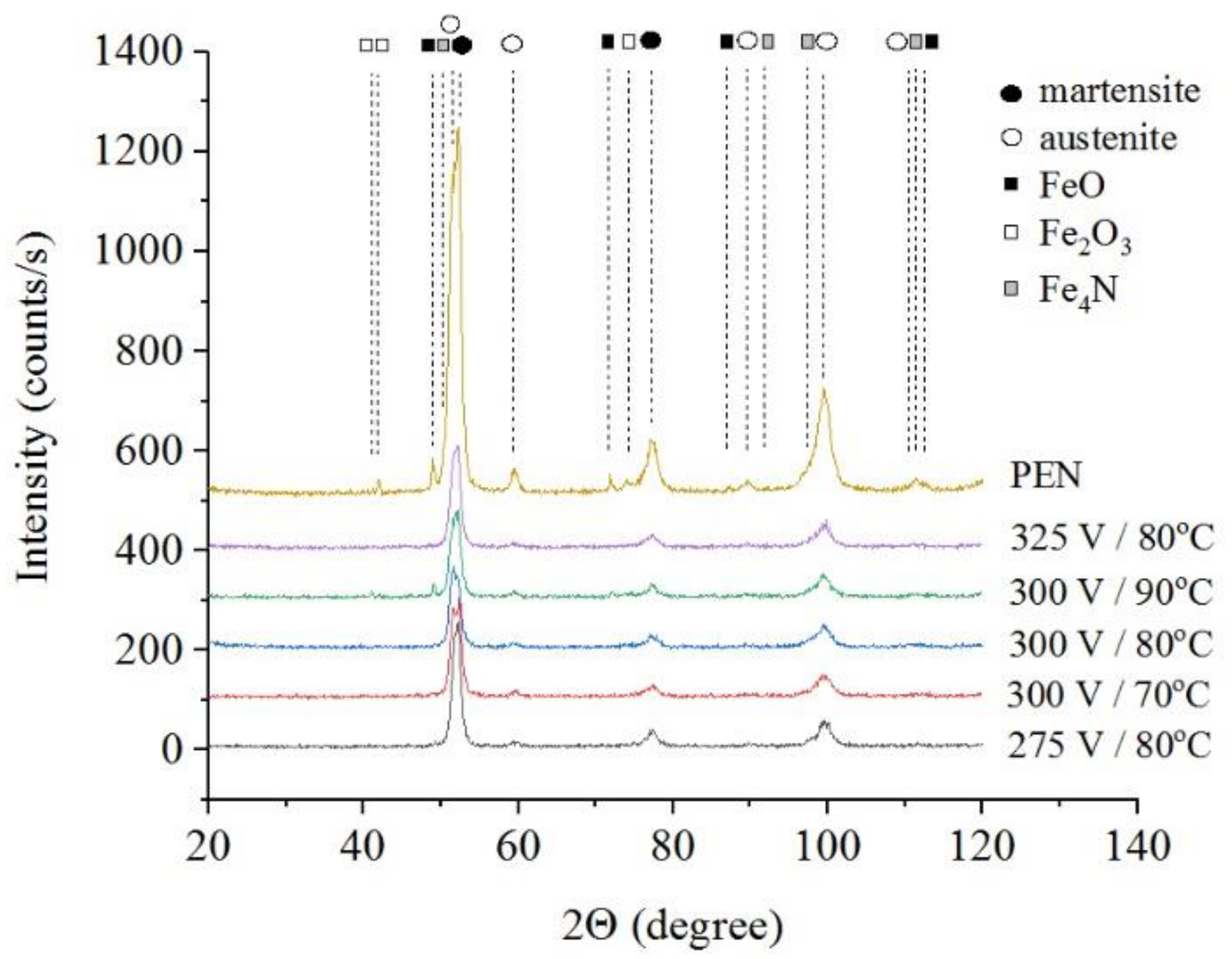
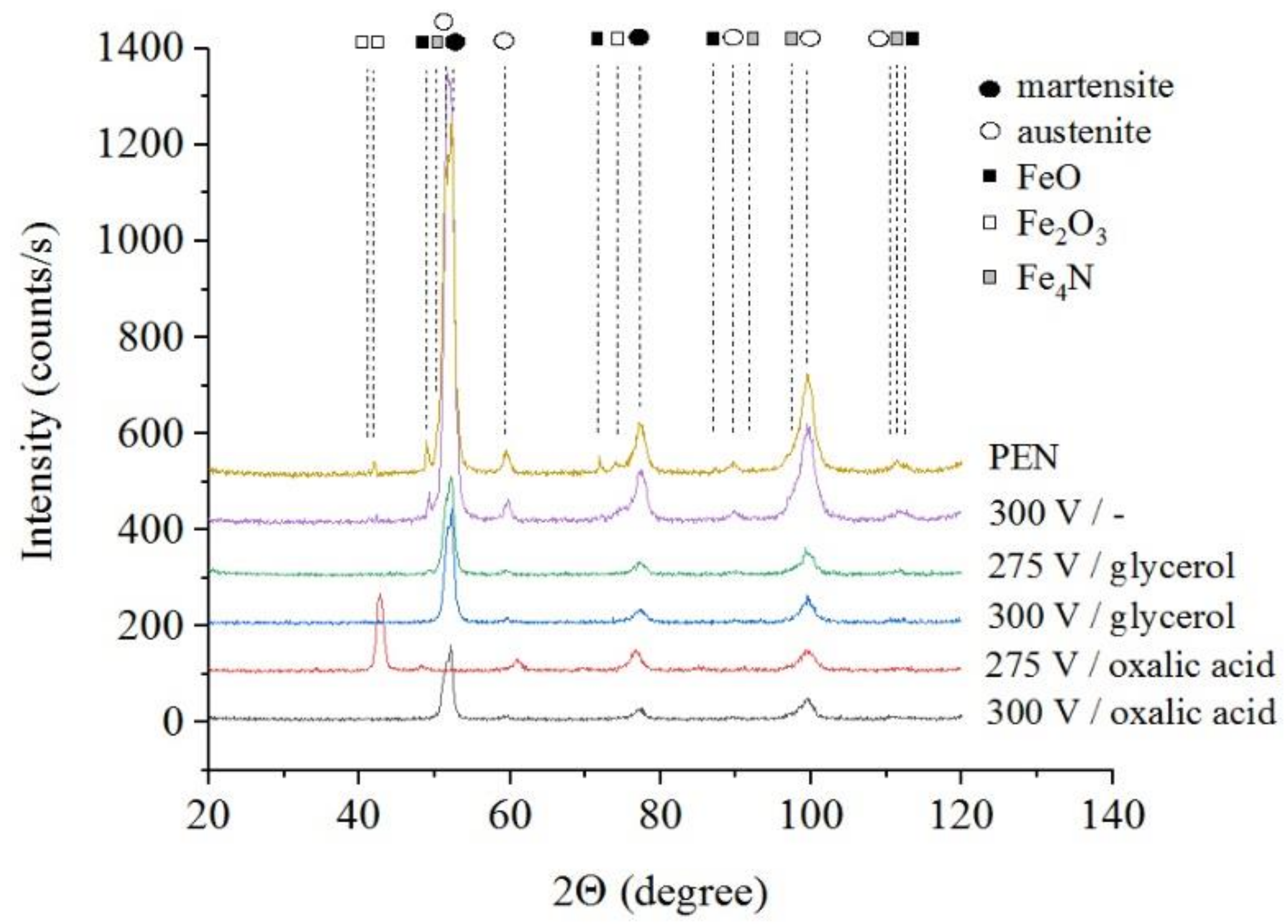



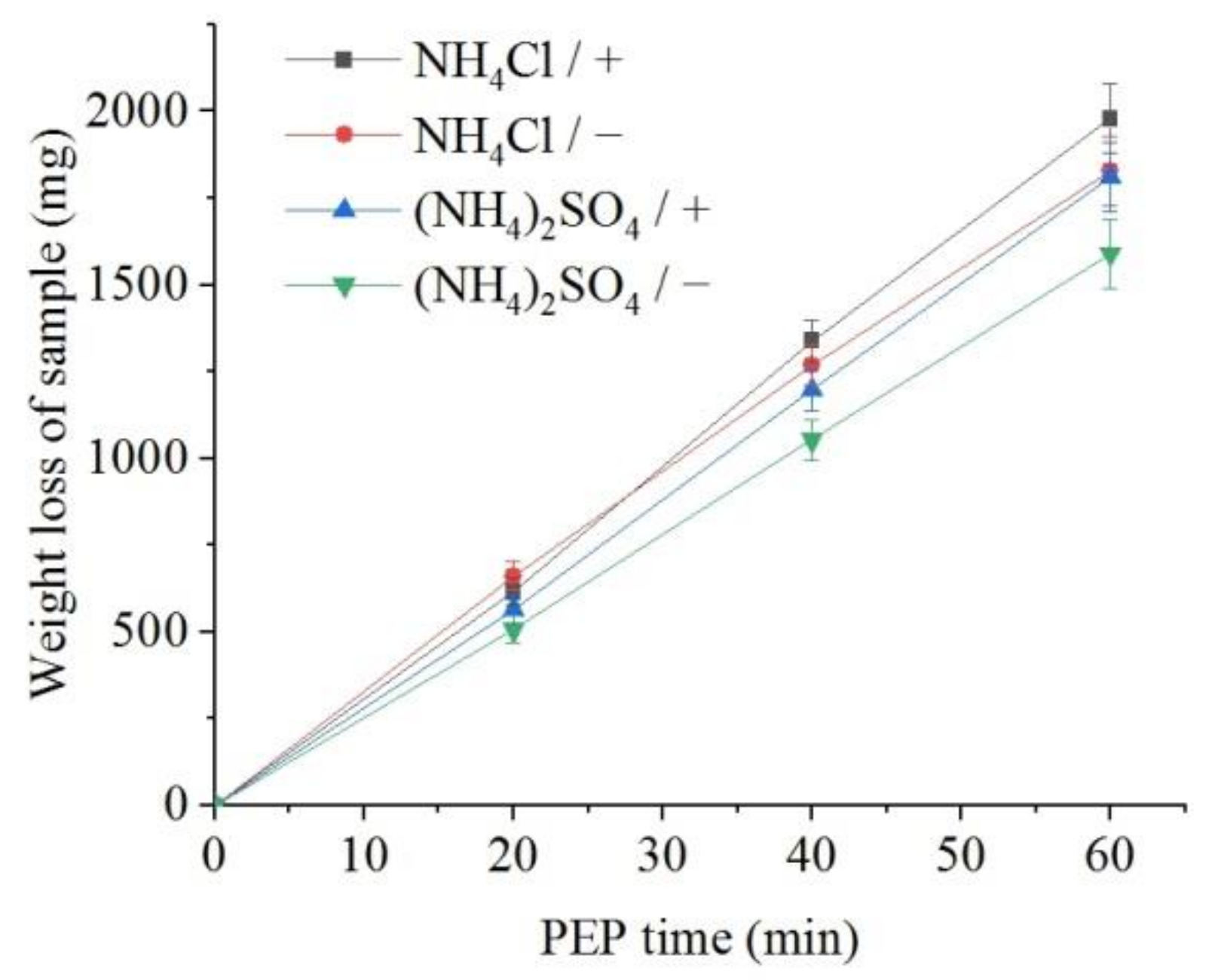

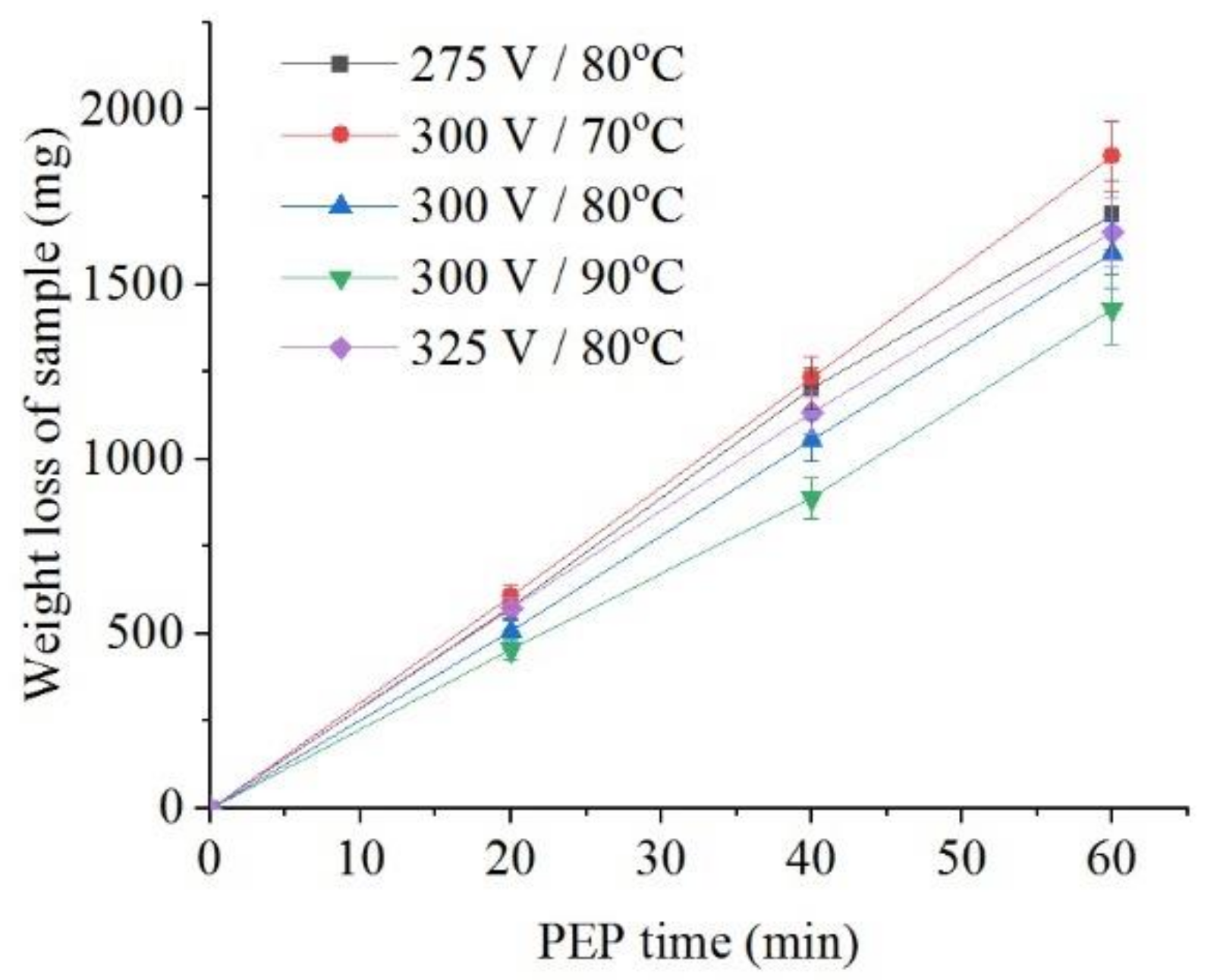
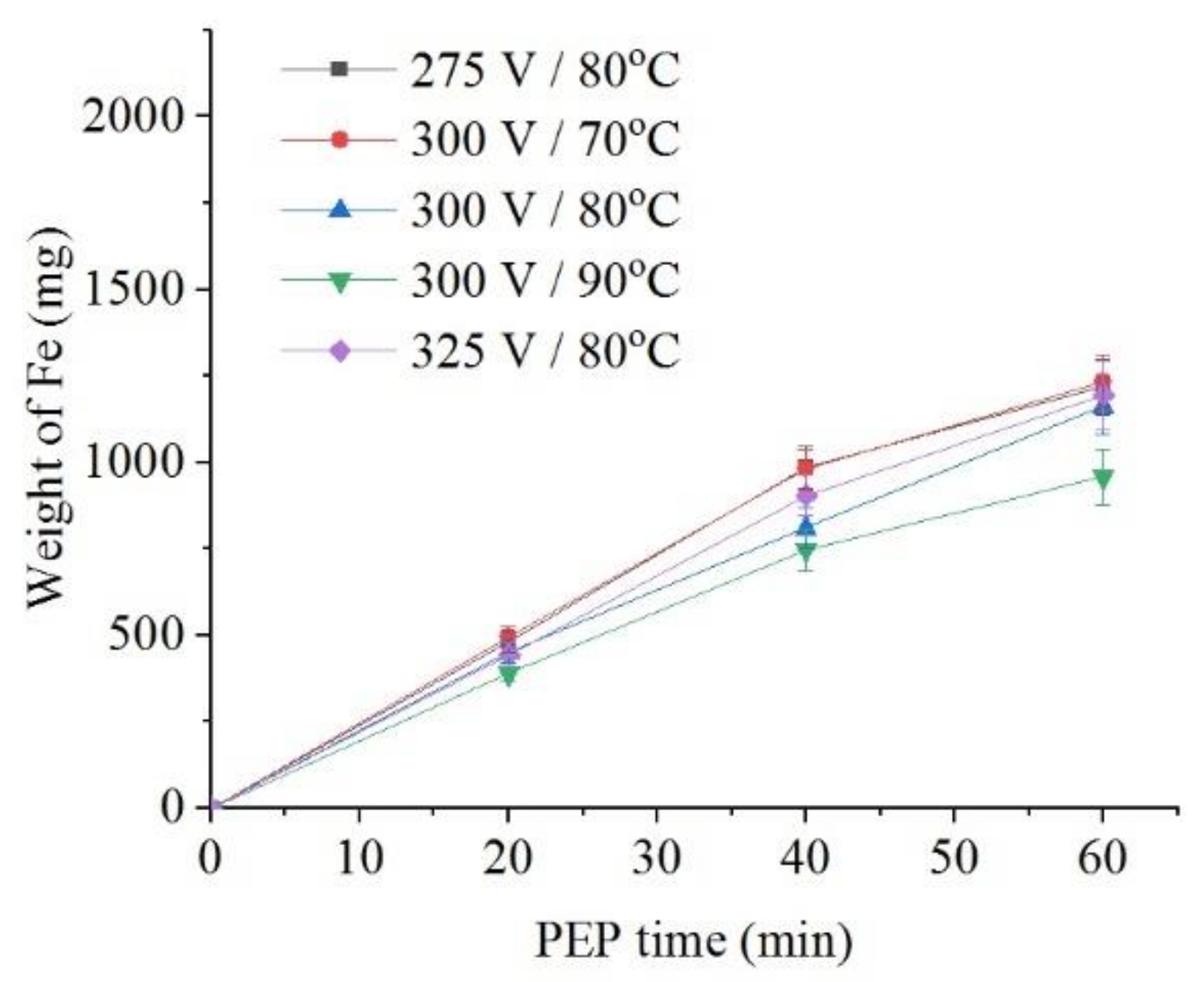
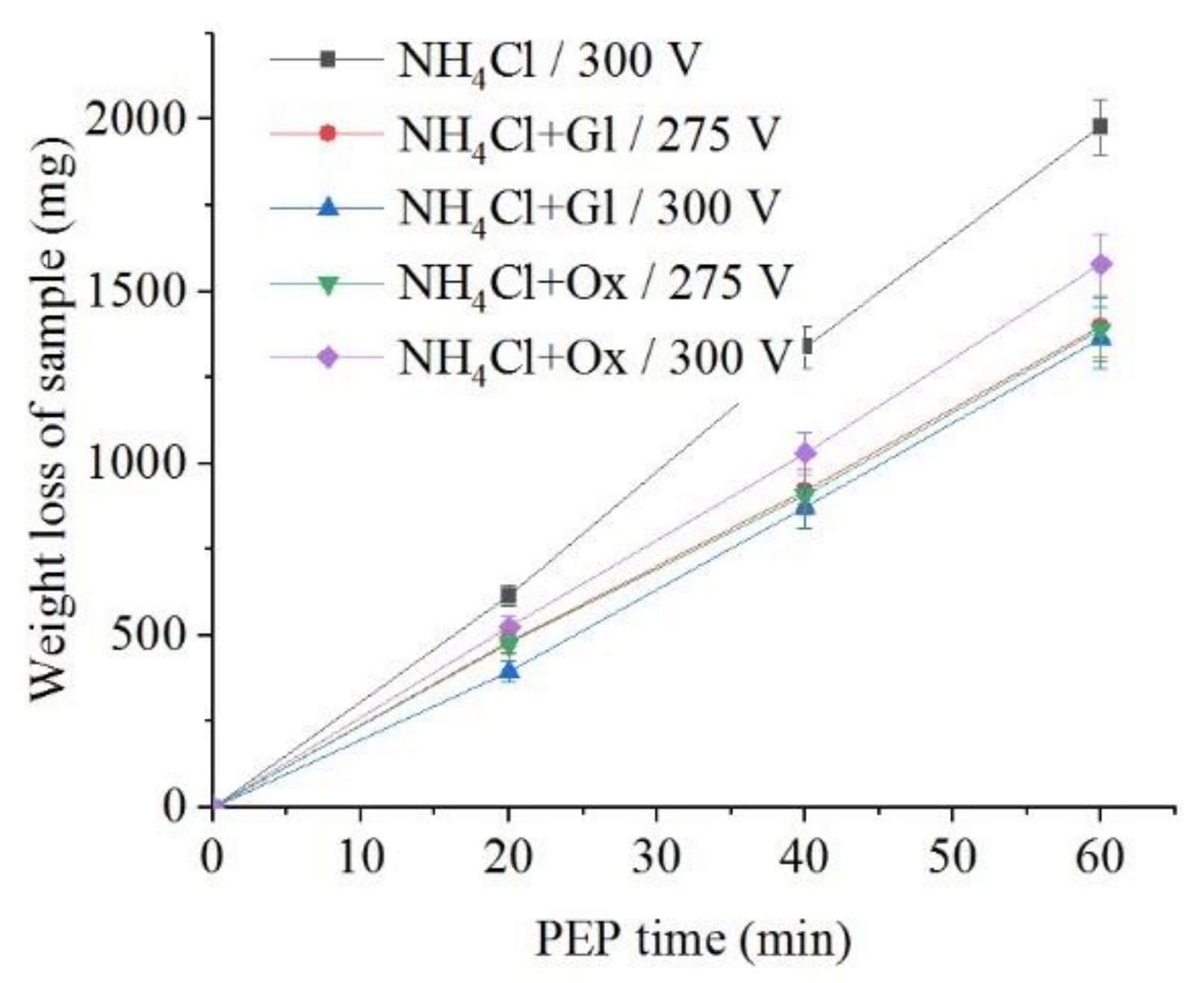
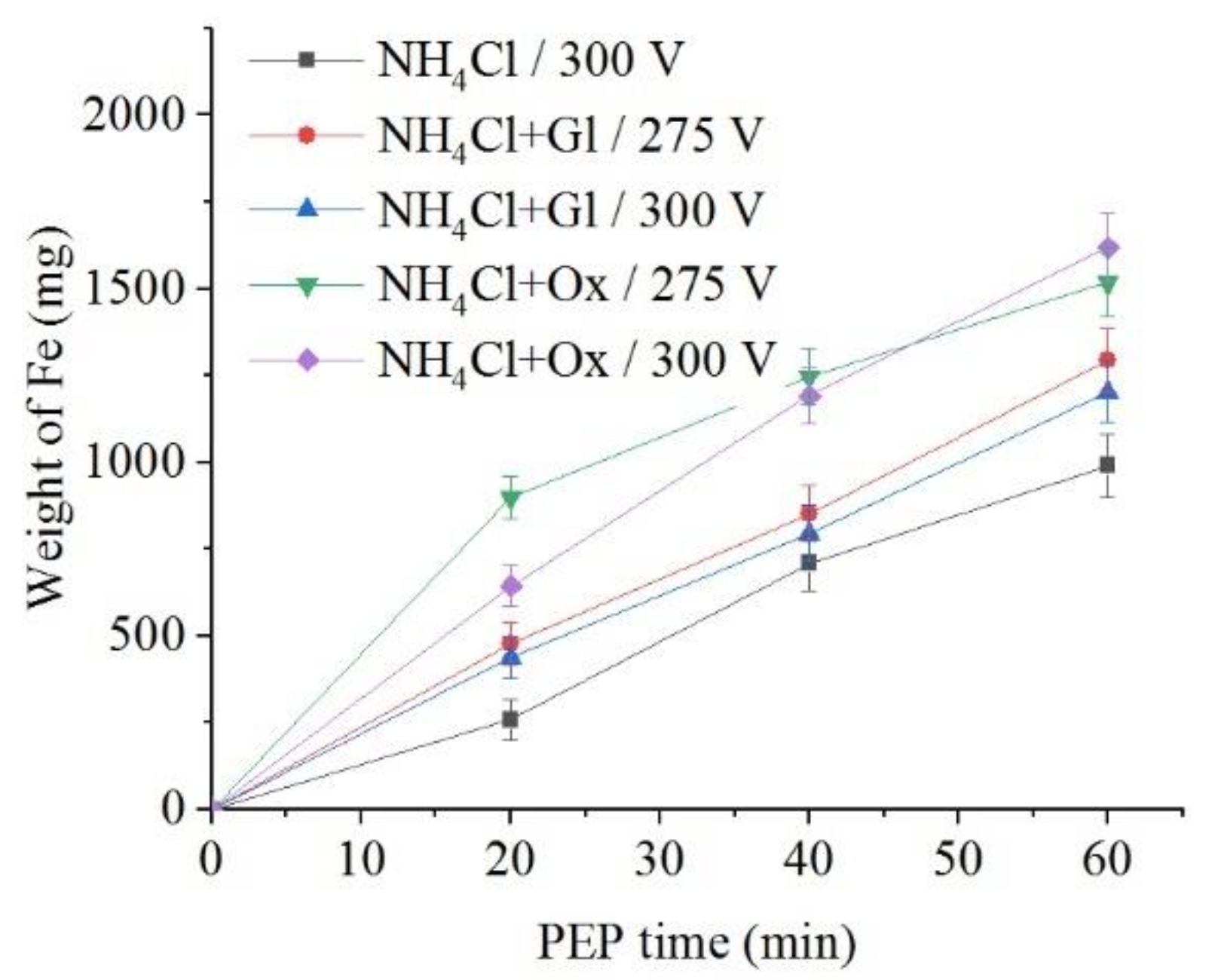
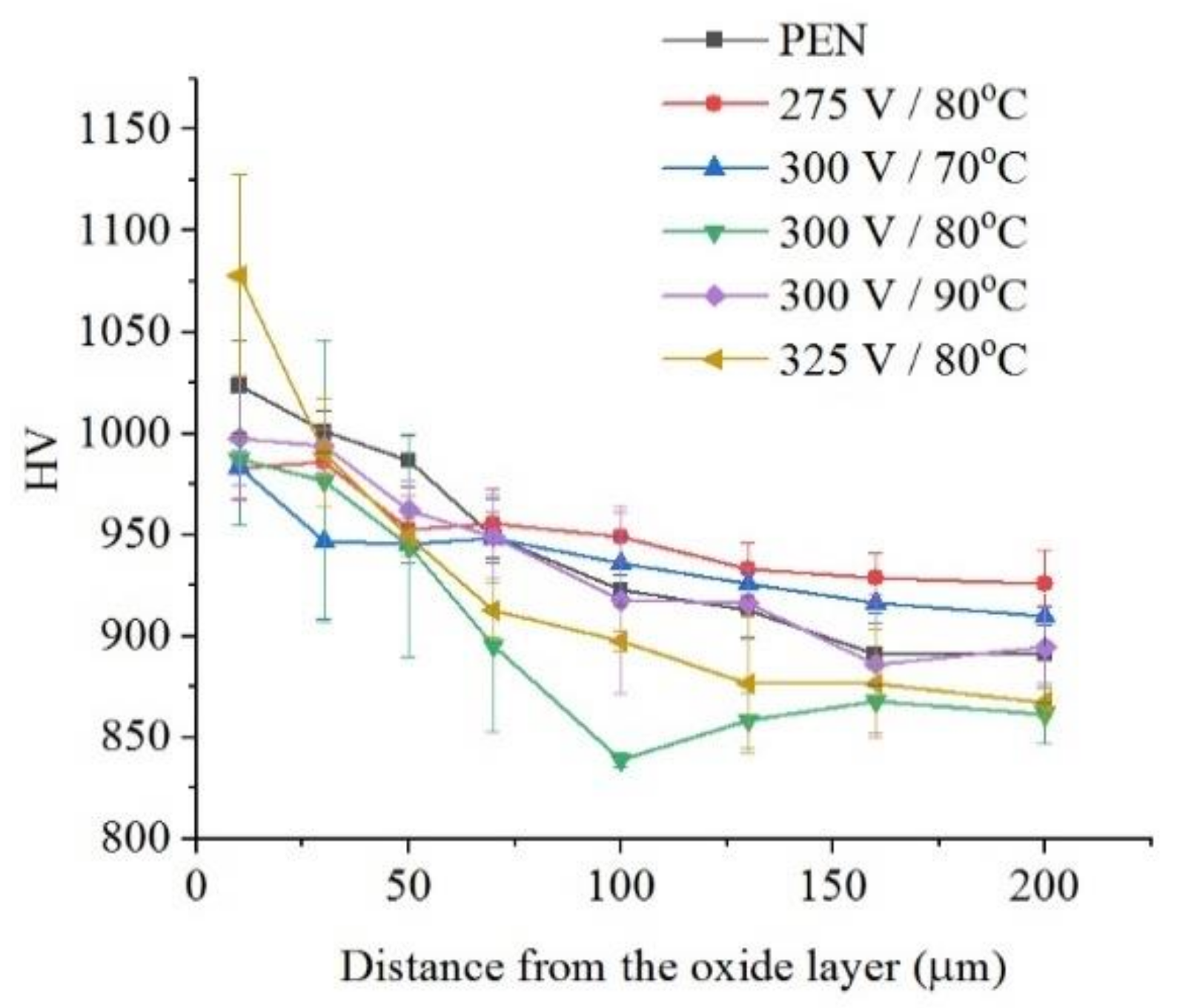



| Electrolyte for PEP | U, V | Tel, °C | HS | I, A | Δm, mg | Ra, μm | j, μA/cm2 | μ | Δmfr, mg |
|---|---|---|---|---|---|---|---|---|---|
| Before treatment | 1.0 ± 0.1 | 23 | 0.61 | 13.8 | |||||
| After PEN | 1.4 ± 0.2 | 19 | 0.65 | 0.25 | |||||
| Ammonium sulfate (3%) | 275 | 80 | − | 1.7 | 28.7 | 0.5 ± 0.1 | 17 | 0.53 | 0.2 |
| 300 | 70 | − | 1.9 | 31.6 | 0.5 ± 0.1 | 13 | 0.54 | 0.2 | |
| 300 | 80 | + | 1.3 | 30.4 | 0.5 ± 0.1 | 14 | 0.61 | 0.4 | |
| 300 | 80 | − | 1.4 | 27.0 | 0.5 ± 0.1 | 12 | 0.56 | 0.6 | |
| 300 | 90 | − | 1.2 | 24.0 | 0.65 ± 0.04 | 10 | 0.54 | 0.5 | |
| 325 | 80 | − | 1.3 | 27.7 | 0.6 ± 0.1 | 19 | 0.55 | 0.2 | |
| Ammonium chloride (3%) | 300 | 80 | + | 1.4 | 33.2 | 0.7 ± 0.1 | 30 | 0.58 | 0.5 |
| 300 | 80 | − | 1.5 | 30.8 | 0.5 ± 0.1 | 16 | 0.54 | 0.2 | |
| Ammonium chloride (3%) + glycerol (5%) | 275 | 80 | + | 1.5 | 23.5 | 0.7 ± 0.1 | 8 | 0.57 | 0.3 |
| 300 | 80 | + | 1.4 | 22.8 | 0.7 ± 0.1 | 14 | 0.54 | 0.4 | |
| Ammonium chloride (3%) + oxalic acid (5%) | 275 | 80 | + | 1.5 | 23.6 | 0.8 ± 0.1 | 26 | 0.54 | 0.4 |
| 300 | 80 | + | 1.4 | 26.7 | 0.56 ± 0.04 | 23 | 0.52 | 0.3 |
Publisher’s Note: MDPI stays neutral with regard to jurisdictional claims in published maps and institutional affiliations. |
© 2021 by the authors. Licensee MDPI, Basel, Switzerland. This article is an open access article distributed under the terms and conditions of the Creative Commons Attribution (CC BY) license (https://creativecommons.org/licenses/by/4.0/).
Share and Cite
Apelfeld, A.; Borisov, A.; Dyakov, I.; Grigoriev, S.; Krit, B.; Kusmanov, S.; Silkin, S.; Suminov, I.; Tambovskiy, I. Enhancement of Medium-Carbon Steel Corrosion and Wear Resistance by Plasma Electrolytic Nitriding and Polishing. Metals 2021, 11, 1599. https://doi.org/10.3390/met11101599
Apelfeld A, Borisov A, Dyakov I, Grigoriev S, Krit B, Kusmanov S, Silkin S, Suminov I, Tambovskiy I. Enhancement of Medium-Carbon Steel Corrosion and Wear Resistance by Plasma Electrolytic Nitriding and Polishing. Metals. 2021; 11(10):1599. https://doi.org/10.3390/met11101599
Chicago/Turabian StyleApelfeld, Andrey, Anatoly Borisov, Ilya Dyakov, Sergey Grigoriev, Boris Krit, Sergei Kusmanov, Sergey Silkin, Igor Suminov, and Ivan Tambovskiy. 2021. "Enhancement of Medium-Carbon Steel Corrosion and Wear Resistance by Plasma Electrolytic Nitriding and Polishing" Metals 11, no. 10: 1599. https://doi.org/10.3390/met11101599
APA StyleApelfeld, A., Borisov, A., Dyakov, I., Grigoriev, S., Krit, B., Kusmanov, S., Silkin, S., Suminov, I., & Tambovskiy, I. (2021). Enhancement of Medium-Carbon Steel Corrosion and Wear Resistance by Plasma Electrolytic Nitriding and Polishing. Metals, 11(10), 1599. https://doi.org/10.3390/met11101599








